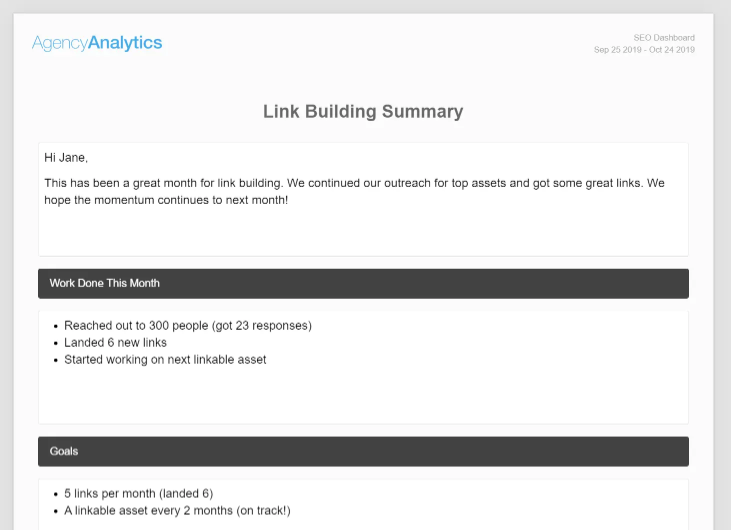How to Build a Digital Marketing Report That Clients Love
Comprehensive marketing reports showcase the value of a marketing agency’s campaigns and help to maintain client relationships. How do marketing agencies showcase their value to clients? With impressive marketing reports. Many marketing agencies struggle with building reports that clients...

Comprehensive marketing reports showcase the value of a marketing agency’s campaigns and help to maintain client relationships.
How do marketing agencies showcase their value to clients? With impressive marketing reports.
Many marketing agencies struggle with building reports that clients actually read. Reports are often difficult to understand, lack engaging visuals, or fail to meet the professional standards that agencies–or their clients–have. To make matters worse, some software or marketing tools on the market don’t offer white-label solutions or helpful customer support when a question arises during busy end-of-the-month reporting.
The good news is that with the right tools and strategies in place, agencies produce reports that are informative and impressive, helping clients fully appreciate the success of their campaigns.
This guide provides everything agencies need to create comprehensive, clear, and visually appealing digital marketing reports.
In this article:
What Is a Digital Marketing Report? Understanding Client Needs How to Structure Marketing Reports for Clarity The Importance of Incorporating Visual Elements Automating Reporting Processes Key Takeaways & SummaryWhat Is a Digital Marketing Report?
Simply put, a digital marketing report is a strategic tool that aligns the goals of your clients with the results of your marketing efforts.
For marketing agencies that regularly produce these reports, the challenge isn’t in drafting a document filled with figures and graphs—it’s in crafting a report that promotes decision-making and showcases the impact of an agency’s work.
The difference between a “good” and “bad” report is how the data is packaged and delivered. A report that clients love needs to interpret the data, highlight key performance indicators and correlate directly with clients’ objectives. It should provide actionable insights, not just raw numbers, and tell a compelling story about what the data means for the client’s business.
Outstanding reports are marked by several key features. Here are a few to keep in mind:
1. They must be well-structured, ensuring that information flows logically and is easy to navigate.
2. Marketing reports should balance textual explanations with visual data representations like charts and graphs, which makes complex information more digestible.
3. Personalization is also key—tailoring the report to reflect the client’s branding and voice indicates professionalism and reinforces the customized nature of your service.
4. Outstanding reports are anticipatory, going beyond a basic summary of past and present performance and offering strategic recommendations for future actions. This forward-looking approach demonstrates a deep understanding of a client’s business and positions an agency as a proactive partner in their success.
Understanding Client Needs
This brings us to our next point. Why does this all matter?
Building a marketing report that clients love requires agencies to understand the ins and outs of their client’s business, how the company operates, and the industry they work within. This makes all the difference between a report that gets tossed in the junk folder and one that is read carefully and analyzed.
Tailoring each report to address specific challenges and opportunities unique to each client will demonstrate your agency’s attention to detail and commitment to their success.
When diving deeper into a client’s business, consider factors beyond surface-level metrics. For example, if a client is struggling with lead generation, the report should focus on the effectiveness of different channels in attracting quality leads, rather than merely reporting on website traffic.
Similarly, for a client concerned with brand perception, emphasize metrics related to engagement and sentiment analysis from social media feedback.
Understanding these nuances helps identify underlying challenges that may not be immediately obvious.
Agency Tip: Take your client reporting one step further by connecting over 80 different marketing platforms to give clients a birds-eye view of their marketing efforts. Try is out for free with a 14-day trial of AgencyAnalytics.
Aligning the report with a client’s business challenges and goals encourages them to make informed decisions that lead to tangible improvements in their marketing strategy (and budget).
How to Structure Marketing Reports for Clarity?
When structuring a marketing report, agencies should aim to ensure that the information is both accessible and actionable.
A well-organized report typically begins with an executive summary, which offers a high-level overview of the findings and key takeaways. This allows decision-makers at a client’s business to grasp the essential points quickly without delving into the finer details immediately.
Following the summary, the report should include a detailed analysis section. Here, data should be segmented by campaign, channel, or demographic, depending on the report’s focus. Each segment should present relevant metrics, supported by visuals like graphs or charts, to clarify trends and outcomes. It’s beneficial to provide annotations or brief explanations that interpret the data, especially when showcasing more complex analytics.
Finish the report with actionable recommendations based on the analysis. This section translates data into strategy, suggesting next steps, potential adjustments, or new tactics to try. For example, if the report identifies a high performing channel, it might recommend reallocating more budget to this area.
Each segment of the report should be clearly labeled with headings and subheadings to guide the reader through the content smoothly to make it easy to understand and use to their benefit.
Here is a breakdown of a clear and concise marketing report:
1. Executive Summary
2. Data Analysis
3. Actionable Recommendations
 Image: An example of a report summary for a client’s link building campaign.
Image: An example of a report summary for a client’s link building campaign.The Importance of Incorporating Visual Elements
As we briefly mentioned, including visual elements helps clients better understand complex data.
For example, a marketing agency uses line graphs to showcase trends in a particular campaign. This might prove that changes in PPC metrics like a client’s ad spend correlate with fluctuations in traffic or conversions over time.
Bar charts are also great for comparing the performance of different social media platforms, highlighting metrics such as engagement rates, follower growth, or post reach.
Incorporating these visuals makes the data more accessible and helps clients visually connect the dots between the marketing activities achieved by the agency and their business outcomes.
Agency Tip: Take a report’s visual elements one step further by incorporating a client’s brand onto the page. AgencyAnalytics allows marketers to offer a fully white labeled experience to their clients, adding an extra touch of personality and professionalism.
Automating Reporting Processes
We’ve outlined how to craft a report that clients will appreciate, emphasizing the importance of proper structure and engaging visuals. However, creating such detailed reports can be time-consuming—time that marketers could otherwise spend developing strategies for their clients.
No one enjoys manually compiling each client’s marketing data every month. Automating your client reporting processes significantly alleviates this challenge.
AgencyAnalytics seamlessly connects to over 80 different marketing platforms, eliminating the need for manual data collection. Plus, agencies set up reports to send automatically on a scheduled basis, guaranteeing consistent and timely delivery without further manual efforts.
Agency Tip: Another great way to speed up report generation is to make use of report templates. For example, a social media report template easily gathers key social media metrics in one place so agencies don’t have to. It’s fully customizable, too, in case you need to adjust anything for a specific client.
Key Takeaways & Summary
A well-defined marketing report always starts with a clear structure. It must include an executive summary, a detailed analysis, and actionable recommendations, ensuring that every piece of information serves a strategic purpose.
Adding visual elements like graphs and charts makes data comprehension easier while keeping clients engaged and compelled by the complex information.
Streamlining the entire reporting process is necessary for scaling agencies. By delivering high-quality, insightful reports, agencies strengthen client relationships, differentiate themselves from competitors, and drive meaningful business outcomes for their clients.
Ultimately, the caliber of a marketing report has the power to significantly influence client satisfaction and retention, marking the difference between a partnership that flourishes and one that flounders.

 Kass
Kass 































